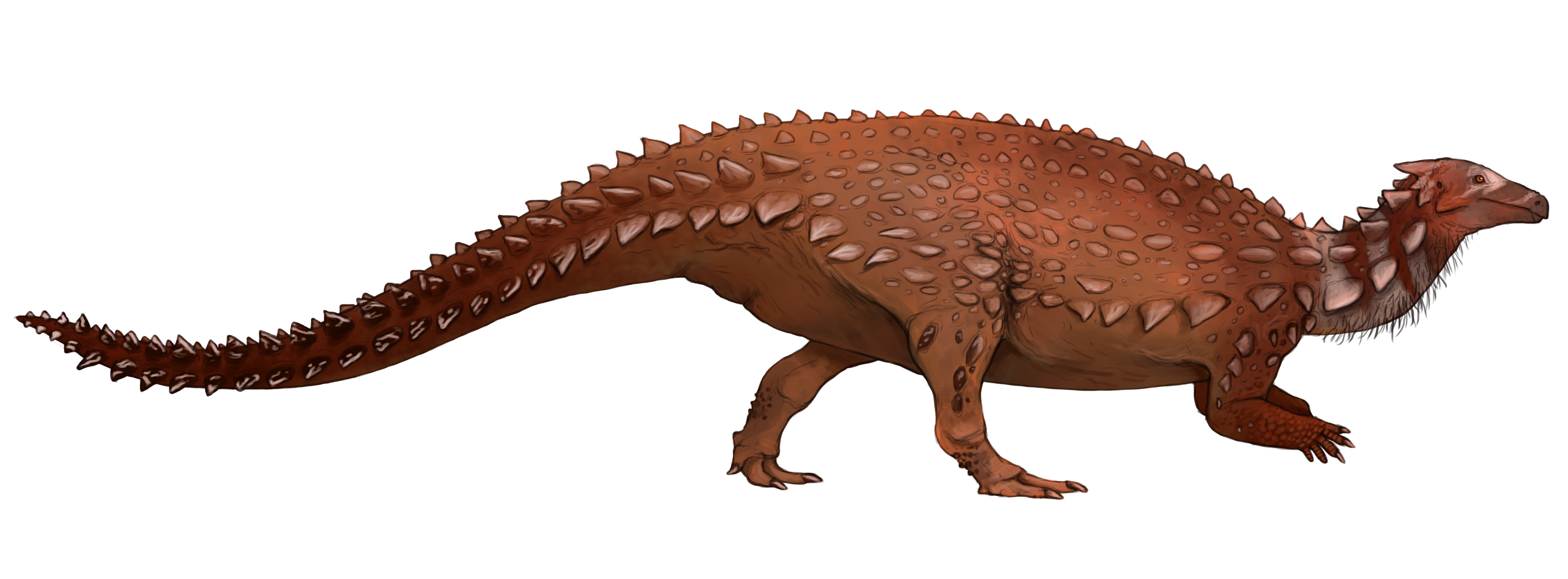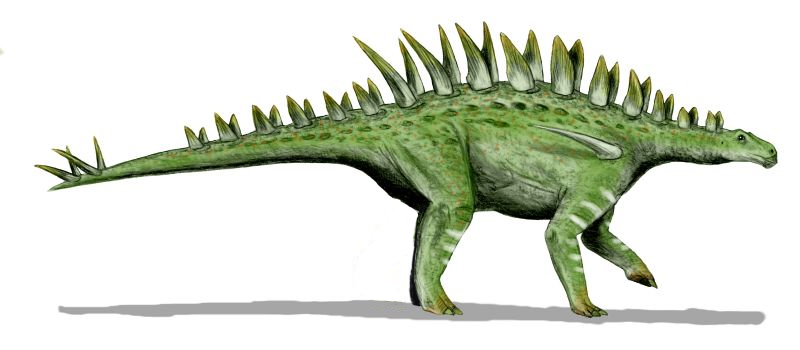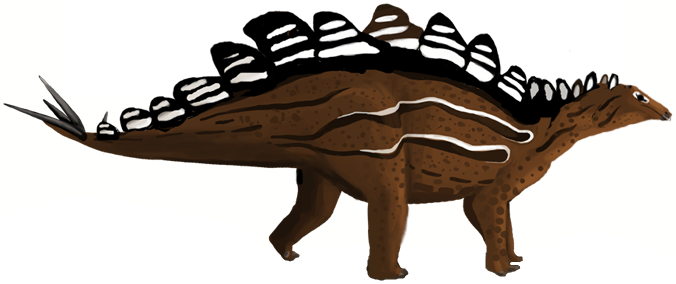|
Yuxisaurus
''Yuxisaurus'' (meaning "Yuxi lizard") is an extinct genus of basal thyreophoran dinosaur from the Early Jurassic (Sinemurian-Toarcian) Fengjiahe Formation of southwestern China. The type species is ''Yuxisaurus kopchicki.'' Discovery and naming ''Yuxisaurus'' was first named in a ''bioRxiv'' preprint released in late 2021, but was not considered valid, due to having not been validly published. The taxon was formally published shortly thereafter, in March 2022. The holotype of the taxon, CVEB 21701, represents a partial skeleton including parts of the skull, several vertebrae, elements of the limbs, and at least 120 osteoderms. The generic name, "''Yuxisaurus''," combines a reference to the type locality in Yuxi, Yunnan Province, China, with the Greek "sauros," meaning "lizard." The specific name, "''kopchicki''," honors the biologist John J. Kopchick. Classification ''Yuxisaurus'' was a basal thyreophoran. Depending on the dataset, it may be the sister taxon to the Ger ... [...More Info...] [...Related Items...] OR: [Wikipedia] [Google] [Baidu] |
Yuxisaurus Size Comparison
''Yuxisaurus'' (meaning "Yuxi lizard") is an extinct genus of basal thyreophoran dinosaur from the Early Jurassic (Sinemurian-Toarcian) Fengjiahe Formation of southwestern China. The type species is ''Yuxisaurus kopchicki.'' Discovery and naming ''Yuxisaurus'' was first named in a ''bioRxiv'' preprint released in late 2021, but was not considered valid, due to having not been validly published. The taxon was formally published shortly thereafter, in March 2022. The holotype of the taxon, CVEB 21701, represents a partial skeleton including parts of the skull, several vertebrae, elements of the limbs, and at least 120 osteoderms. The generic name, "''Yuxisaurus''," combines a reference to the type locality in Yuxi, Yunnan Province, China, with the Greek "sauros," meaning "lizard." The specific name, "''kopchicki''," honors the biologist John J. Kopchick. Classification ''Yuxisaurus'' was a basal thyreophoran. Depending on the dataset, it may be the sister taxon to the Germa ... [...More Info...] [...Related Items...] OR: [Wikipedia] [Google] [Baidu] |
Thyreophora
Thyreophora ("shield bearers", often known simply as "armored dinosaurs") is a group of armored ornithischian dinosaurs that lived from the Early Jurassic until the end of the Cretaceous. Thyreophorans are characterized by the presence of body armor lined up in longitudinal rows along the body. Primitive forms had simple, low, keeled scutes or osteoderms, whereas more derived forms developed more elaborate structures including spikes and plates. Most thyreophorans were herbivorous and had relatively small brains for their body size. Thyreophora includes various subgroups, including the suborders Ankylosauria and Stegosauria. In both the suborders, the forelimbs were much shorter than the hindlimbs, particularly in stegosaurs. The clade has been defined as the group consisting of all species more closely related to ''Ankylosaurus'' than to ''Triceratops''. Thyreophora is the sister group of Cerapoda within Genasauria. Groups of thyreophorans Basal thyreophorans Basal thyreop ... [...More Info...] [...Related Items...] OR: [Wikipedia] [Google] [Baidu] |
2022 In Archosaur Paleontology
This article records new taxa of fossil archosaurs of every kind that are scheduled described during the year 2022, as well as other significant discoveries and events related to paleontology of archosaurs that are scheduled to occur in the year 2022. Pseudosuchians New pseudosuchian taxa General pseudosuchian research * A study on the mandible embryogenesis in extant caimans, and on its implications for the knowledge of the evolution of postdentary lower jaw of pseudosuchians, is published by Bona ''et al.'' (2022). * A study on the musculature of crocodylian and fossil suchian jaws, investigating the impact of the flattening of the skulls of suchians in their evolutionary history on their muscle anatomy, is published by Sellers ''et al.'' (2022). * Revision of ''Tsylmosuchus donensis'' and ''Scythosuchus basileus'' is published by Sennikov (2022), who interprets the latter taxon as a junior synonym of the former one, and interprets ''T. donensis'' as a likely member of ... [...More Info...] [...Related Items...] OR: [Wikipedia] [Google] [Baidu] |
Thyreophora
Thyreophora ("shield bearers", often known simply as "armored dinosaurs") is a group of armored ornithischian dinosaurs that lived from the Early Jurassic until the end of the Cretaceous. Thyreophorans are characterized by the presence of body armor lined up in longitudinal rows along the body. Primitive forms had simple, low, keeled scutes or osteoderms, whereas more derived forms developed more elaborate structures including spikes and plates. Most thyreophorans were herbivorous and had relatively small brains for their body size. Thyreophora includes various subgroups, including the suborders Ankylosauria and Stegosauria. In both the suborders, the forelimbs were much shorter than the hindlimbs, particularly in stegosaurs. The clade has been defined as the group consisting of all species more closely related to ''Ankylosaurus'' than to ''Triceratops''. Thyreophora is the sister group of Cerapoda within Genasauria. Groups of thyreophorans Basal thyreophorans Basal thyreop ... [...More Info...] [...Related Items...] OR: [Wikipedia] [Google] [Baidu] |
Thyreophorans
Thyreophora ("shield bearers", often known simply as "armored dinosaurs") is a group of armored ornithischian dinosaurs that lived from the Early Jurassic until the end of the Cretaceous. Thyreophorans are characterized by the presence of body armor lined up in longitudinal rows along the body. Primitive forms had simple, low, keeled scutes or osteoderms, whereas more derived forms developed more elaborate structures including spikes and plates. Most thyreophorans were herbivorous and had relatively small brains for their body size. Thyreophora includes various subgroups, including the suborders Ankylosauria and Stegosauria. In both the suborders, the forelimbs were much shorter than the hindlimbs, particularly in stegosaurs. The clade has been defined as the group consisting of all species more closely related to ''Ankylosaurus'' than to ''Triceratops''. Thyreophora is the sister group of Cerapoda within Genasauria. Groups of thyreophorans Basal thyreophorans Basal thyreop ... [...More Info...] [...Related Items...] OR: [Wikipedia] [Google] [Baidu] |
Eurypoda
Thyreophora ("shield bearers", often known simply as "armored dinosaurs") is a group of armored ornithischian dinosaurs that lived from the Early Jurassic until the end of the Cretaceous. Thyreophorans are characterized by the presence of body armor lined up in longitudinal rows along the body. Primitive forms had simple, low, keeled scutes or osteoderms, whereas more derived forms developed more elaborate structures including spikes and plates. Most thyreophorans were herbivorous and had relatively small brains for their body size. Thyreophora includes various subgroups, including the suborders Ankylosauria and Stegosauria. In both the suborders, the forelimbs were much shorter than the hindlimbs, particularly in stegosaurs. The clade has been defined as the group consisting of all species more closely related to ''Ankylosaurus'' than to ''Triceratops''. Thyreophora is the sister group of Cerapoda within Genasauria. Groups of thyreophorans Basal thyreophorans Basal thy ... [...More Info...] [...Related Items...] OR: [Wikipedia] [Google] [Baidu] |
John Kopchick
John Kopchick is a molecular biologist and co-inventor of the drug Somavert (Pegvisomant Pegvisomant, sold under the brand name Somavert, is a growth hormone receptor antagonist used in the treatment of acromegaly. It is primarily used if the pituitary gland tumor causing the acromegaly cannot be controlled with surgery or radiatio ...), which has improved the lives of acromegaly, acromegalic individuals around the world. He is currently the Goll-Ohio Eminent Scholar and Professor of Molecular Biology in the Department of Biomedical Sciences at the Ohio University Heritage College of Osteopathic Medicine. Dr. Kopchick's groundbreaking work in the field of growth hormone has helped shape the study of endocrinology. Early life John Joseph Kopchick was born in Punxsutawney, Pennsylvania on November 2, 1950, to Peter Kopchick and Kathryn Gabster Kopchick and spent the first four years of his life with the "groundhog". The family then moved to a small coal-mining town: Ernest, ... [...More Info...] [...Related Items...] OR: [Wikipedia] [Google] [Baidu] |
Fengjiahe Formation
The Fengjiahe Formation is a geological formation in China. It dates back to the Early Jurassic, most likely to the Pliensbachian. The formation is up to 1500 metres thick and consists of "purple-red mudstone and argillaceous siltstone interbedded with gray-green and yellow-green quartz sandstone and feldspathic quartz sandstone" Fossil content Theropod tracks geographically present in Yunnan, China.Weishampel, David B; et al. (2004). "Dinosaur distribution (Early Jurassic, Asia)." In: Weishampel, David B.; Dodson, Peter; and Osmólska, Halszka (eds.): The Dinosauria, 2nd, Berkeley: University of California Press. Pp. 534–535. . See also * List of dinosaur-bearing rock formations This list of dinosaur-bearing rock formations is a list of geologic formations in which dinosaur fossils have been documented. Containing body fossils * List of stratigraphic units with dinosaur body fossils ** List of stratigraphic units with few ... References {{Reflist Geologic formation ... [...More Info...] [...Related Items...] OR: [Wikipedia] [Google] [Baidu] |
Laquintasaura
''Laquintasaura'' is a genus of Venezuelan Ornithischia, ornithischian dinosaur containing only the type species ''Laquintasaura venezuelae''. The species was the first dinosaur to have been identified from Venezuela. It is known from extensive remains, all from a singular bonebed locality which has been sampled for specimen blocks over the course of several expeditions, largely led by Marcelo R Sánchez-Villagra. A small, very primitive animal, it is known for its distinct dental anatomy and for being one of the earliest and most primitive ornithischians in the fossil record. Taxonomic uncertainty has led to conflicting theories that it is either as the base of Ornithischia or at the base of the subgroup Thyreophora. In either model, its dating to around 200 million years ago, at the start of the Jurassic, existence in equatorial latitudes, and primitive nature make it a key view into early ornithischian evolution. It's thought that ''Laquintasaura'' would've lived in groups and ... [...More Info...] [...Related Items...] OR: [Wikipedia] [Google] [Baidu] |
Ankylosauria
Ankylosauria is a group of herbivorous dinosaurs of the order Ornithischia. It includes the great majority of dinosaurs with armor in the form of bony osteoderms, similar to turtles. Ankylosaurs were bulky quadrupeds, with short, powerful limbs. They are known to have first appeared in the Middle Jurassic, and persisted until the end of the Cretaceous Period. The two main families of Ankylosaurs, Nodosauridae and Ankylosauridae are primarily known from the Northern Hemisphere, but the more basal Parankylosauria are known from southern Gondwana during the Cretaceous. Ankylosauria was first named by Henry Fairfield Osborn in 1923.Osborn, H. F. (1923). "Two Lower Cretaceous dinosaurs of Mongolia." ''American Museum Novitates'', 95: 1–1/ref> In the Linnaean classification system, the group is usually considered either a suborder or an infraorder. It is contained within the group Thyreophora, which also includes the stegosaurs, armored dinosaurs known for their combination of plate ... [...More Info...] [...Related Items...] OR: [Wikipedia] [Google] [Baidu] |
Scutellosaurus
''Scutellosaurus'' ( ) is a genus of thyreophoran ornithischian dinosaur that lived approximately 196 million years ago during the early part of the Jurassic Period in what is now Arizona, USA. It is classified in Thyreophora, the armoured dinosaurs; its closest relatives may have been ''Emausaurus'' and ''Scelidosaurus'', another armored dinosaur which was mainly a quadrupedal dinosaur, unlike bipedal ''Scutellosaurus''. It is one of the earliest representatives of the armored dinosaurs and the basalmost form discovered to date. ''Scutellosaurus'' was a small, lightly-built, ground-dwelling, herbivore, that could grow up to an estimated long. Etymology The genus name ''Scutellosaurus'' means "little-shielded lizard", and is derived from the Latin word "scutellum" meaning "little shield", and the Greek word "sauros" (σαύρα) meaning "lizard". The type and only valid species known today is ''Scutellosaurus lawleri''. The specific name honors David Lawler who collected the ... [...More Info...] [...Related Items...] OR: [Wikipedia] [Google] [Baidu] |
Ankylosauromorpha
Ankylosauria is a group of herbivorous dinosaurs of the order Ornithischia. It includes the great majority of dinosaurs with armor in the form of bony osteoderms, similar to turtles. Ankylosaurs were bulky quadrupeds, with short, powerful limbs. They are known to have first appeared in the Middle Jurassic, and persisted until the end of the Cretaceous Period. The two main families of Ankylosaurs, Nodosauridae and Ankylosauridae are primarily known from the Northern Hemisphere, but the more basal Parankylosauria are known from southern Gondwana during the Cretaceous. Ankylosauria was first named by Henry Fairfield Osborn in 1923.Osborn, H. F. (1923). "Two Lower Cretaceous dinosaurs of Mongolia." ''American Museum Novitates'', 95: 1–1/ref> In the Linnaean classification system, the group is usually considered either a suborder or an infraorder. It is contained within the group Thyreophora, which also includes the stegosaurs, armored dinosaurs known for their combination of plates ... [...More Info...] [...Related Items...] OR: [Wikipedia] [Google] [Baidu] |







